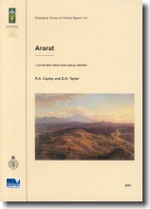GSV Report 115 - Ararat 1:100 000 map area geological report
 |
| |||||||||||||||||||||||||||||||||||||||||||||||||||||||||||||||||||||||
Product description:Download The downloadable version of this report is supplied in PDF format and is a large high resolution file (94.3MB). Abstract This report describes the geology of the area covered by the ARARAT 1:100 000 mapsheet 7423. It gives a comprehensive account of the rock units, the geological structure, geomorphology and economic geology. The regional geological setting, geological history, landscape evolution and a summary of previous geological work, mineral exploration and literature references are also presented. A varied Cambrian basement comprises parts of the Delamerian and Lachlan fold belts, juxtaposed along the Moyston Fault which is the boundary between the fold belts. The Cambrian rocks of the different fold belts were deformed at different times. The Delamerian Fold Belt rocks lie to the west of the Moyston Fault, and are a submarine sequence of Late Cambrian calc-alkaline intermediate volcanics (Mount Stavely Volcanics) and overlying quartz-rich turbidites (Glenthompson Sandstone) that probably represent infill of a syn-orogenic Delamerian basin. These rocks were weakly deformed in the Late Cambrian. Lying unconformably to para-autochthonously upon these rocks is a sequence of Silurian fluvial to shallow marine sandstone and mudstone, the Grampians Group. These rocks were deformed in the Late Silurian, and are separated from the Delamerian basement by a regional-scale décollement. In ARARAT, the Grampians Group has been partially thrust–stacked, and represents an outlier of the Lachlan Fold Belt. All these Palaeozoic rocks are grouped as the Grampians–Stavely Zone. The Lachlan Fold Belt rocks immediately east of the Moyston Fault were first deformed in the Late Ordovician-Early Silurian, much later than the Delamerian Fold Belt. The Lachlan Fold Belt in ARARAT includes a belt of deformed metamorphic rocks–the Moornambool Metamorphic Complex. Rocks in this complex show increasing pressures and temperatures of formation towards the Moyston Fault. The metamorphic complex is a fault zone which represents mid-crustal levels of the Lachlan Fold Belt, uplifted in the Silurian by large-scale thrusting on the east-dipping Moyston Fault. The metamorphic rocks are predominantly mafic volcanic and pelitic schists (Carrolls Amphibolite and the Lexington and Good Morning Bill schists) formed in the Silurian. Lower grade and less deformed Cambrian protoliths are exposed in the eastern parts of the metamorphic complex (Magdala Volcanics and Warrak Formation). East of the metamorphic complex is a sequence of Cambrian distal deep marine turbidites (Warrak Formation) typical of the Lachlan Fold Belt. These were tightly folded and cleaved in the Late Ordovician-Early Silurian. All these rocks are grouped as the Stawell Zone. The Delamerian Orogeny to the west of the Moyston Fault was probably driven by a poorly documented Cambrian arc–continent collision along a convergent margin that now lies buried beneath younger rocks, west of ARARAT. The Late Ordovician-Silurian deformation of the Lachlan Fold Belt and the Grampians Group represents a period of renewed convergence which accreted the Lachlan Fold Belt to the older Delamerian craton. In the vicinity of the fold belt boundary there appears to have been some extensional faulting. Several rocks types, including the Grampians Group and some underlying belts of Cambrian volcanics, were partially segmented with resulting complex distribution patterns. Associated with—or shortly following—this extension, numerous plutons intruded both fold belts to shallow levels in the Early Devonian. Most of the plutons are I-type granites and some have small diorite and gabbro apophyses. The region has been relatively tectonically stable since the Devonian with prolonged erosion, rejuvenated during late Mesozoic to Cainozoic uplift associated with Australia–Antarctica break-up. The present landscape has emerged after several cycles of erosion and sedimentation related to this uplift. The landscape was partly modified in the late Cainozoic by basaltic volcanism (the Newer Volcanics) and a minor marine incursion of the Murray Basin. Significant orogenic gold mineralisation occurs in quartz reefs in Stawell Zone basement. The mineralisation is structurally controlled, emplaced during regional Late Ordovician-Silurian deformation. Significant amounts have been reworked into placer gold deposits in several generations of Cainozoic fluvial deposits that lie scattered across the basement. Non-metallic resources comprise sand and gravel derived largely from Cainozoic units, basalt from the Cainozoic lava flows and clay from weathered basement. Significant groundwater aquifer systems occur in some of the Cainozoic units. A comprehensive reference list and numerous photographs, diagrams and tables complement the text. The text concludes with a detailed excursion guide designed to show the major geological features and economic mineral resources of the area. Bibliographic reference Cayley, R.A. & Taylor, D.H., 2001. Ararat 1:100 000 map area geological report. Geological Survey of Victoria Report 115. Related products:
| ||||||||||||||||||||||||||||||||||||||||||||||||||||||||||||||||||||||||






